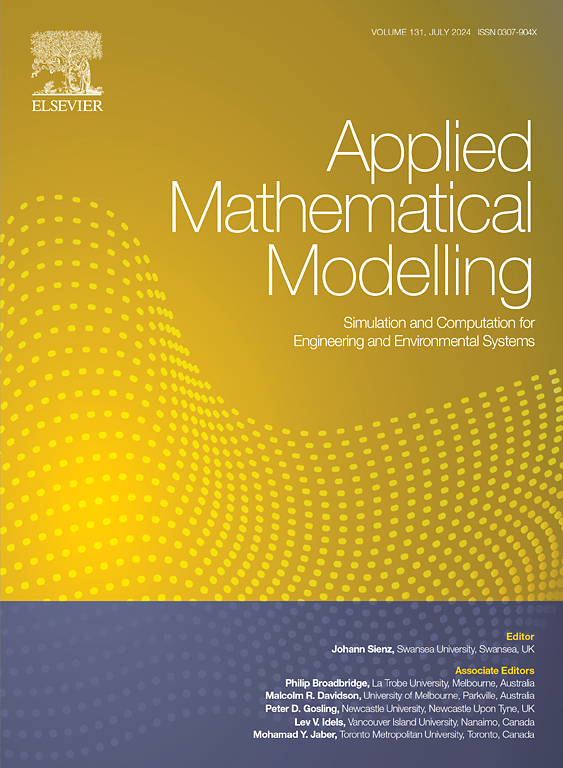The plane thermoelastic analysis of asymmetric collinear crack interactions in one-dimensional hexagonal quasicrystals
IF 4.4
2区 工程技术
Q1 ENGINEERING, MULTIDISCIPLINARY
引用次数: 0
Abstract
The interaction between cracks is the main cause of material failure when the material contains multiple cracks. Using the classical Kachanov method and Fourier integral transformation, the thermoelastic behavior of one-dimensional hexagonal (1DH) quasicrystals (QCs) containing two asymmetric collinear cracks in a non-periodic plane is studied. Considering the interaction between cracks, the solutions of the thermal stress intensity factors (TSIFs), and strain energy density factors (SEDFs) are determined. Numerical results analyze the influence of the coupling coefficients, external loads, thermal conductivity and crack interaction coefficients on the temperature, TSIFs and SEDFs. The results show that when the spacing between cracks is smaller than the length of each crack, the collinear cracks will influence each other more. The propagation of cracks can be suppressed by selecting QCs with appropriate coupling coefficients. These results enhance the understanding of crack interaction mechanisms in QCs and the impact of micro-cracks on the main crack, with a novel contribution being the comprehensive consideration of both crack interaction in QCs using the Kachanov method.
一维六方准晶中不对称共线裂纹相互作用的平面热弹性分析
当材料含有多个裂纹时,裂纹间的相互作用是导致材料失效的主要原因。利用经典的Kachanov方法和傅里叶积分变换,研究了在非周期平面上含有两个非对称共线裂纹的一维六边形准晶体的热弹性行为。考虑裂纹之间的相互作用,确定了热应力强度因子(TSIFs)和应变能密度因子(SEDFs)的解。数值结果分析了耦合系数、外载荷、导热系数和裂纹相互作用系数对温度、TSIFs和SEDFs的影响。结果表明:当裂纹间距小于每条裂纹长度时,共线裂纹的相互影响更大;通过选择合适的耦合系数,可以抑制裂纹的扩展。这些结果增强了对qc中裂纹相互作用机制和微裂纹对主裂纹影响的理解,其中一个新颖的贡献是使用Kachanov方法综合考虑qc中两种裂纹相互作用。
本文章由计算机程序翻译,如有差异,请以英文原文为准。
求助全文
约1分钟内获得全文
求助全文
来源期刊

Applied Mathematical Modelling
数学-工程:综合
CiteScore
9.80
自引率
8.00%
发文量
508
审稿时长
43 days
期刊介绍:
Applied Mathematical Modelling focuses on research related to the mathematical modelling of engineering and environmental processes, manufacturing, and industrial systems. A significant emerging area of research activity involves multiphysics processes, and contributions in this area are particularly encouraged.
This influential publication covers a wide spectrum of subjects including heat transfer, fluid mechanics, CFD, and transport phenomena; solid mechanics and mechanics of metals; electromagnets and MHD; reliability modelling and system optimization; finite volume, finite element, and boundary element procedures; modelling of inventory, industrial, manufacturing and logistics systems for viable decision making; civil engineering systems and structures; mineral and energy resources; relevant software engineering issues associated with CAD and CAE; and materials and metallurgical engineering.
Applied Mathematical Modelling is primarily interested in papers developing increased insights into real-world problems through novel mathematical modelling, novel applications or a combination of these. Papers employing existing numerical techniques must demonstrate sufficient novelty in the solution of practical problems. Papers on fuzzy logic in decision-making or purely financial mathematics are normally not considered. Research on fractional differential equations, bifurcation, and numerical methods needs to include practical examples. Population dynamics must solve realistic scenarios. Papers in the area of logistics and business modelling should demonstrate meaningful managerial insight. Submissions with no real-world application will not be considered.
 求助内容:
求助内容: 应助结果提醒方式:
应助结果提醒方式:


